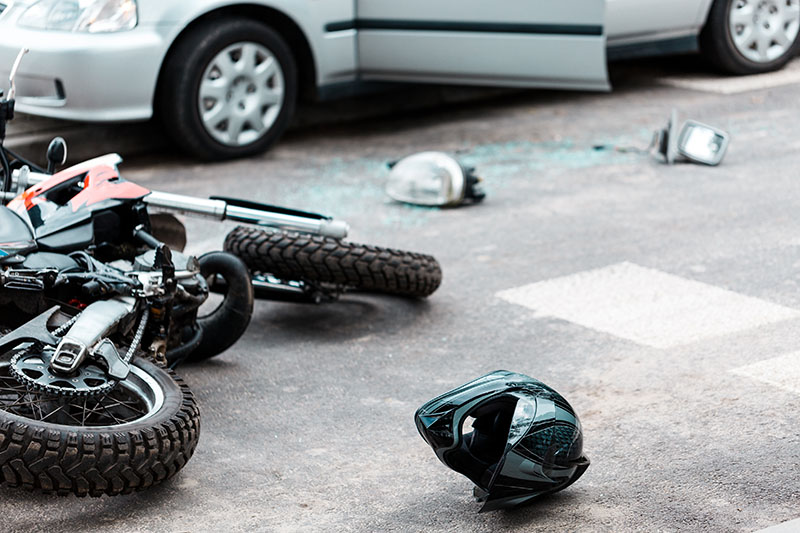
Motorcyclists - motorcycle riders and their passengers – account for 14 percent of all traffic fatalities, despite representing only 3 percent of registered motor vehicles in the U.S., according to data from the National Highway Traffic Safety Administration.
With that number on the rise – 9 % in the last year – it's essential for motorcyclists to know their rights in the event of a motorcycle crash.
Paul Hoybjerg and his team at Hoybjerg Law are experienced motorcycle accident lawyers. They'll help you receive a fair settlement – if you don't win, you don't pay
What Is A Personal Injury Lawsuit?
In broad terms, an injured person can file a claim against the party who allegedly caused the injury through negligence. The lawsuit allows you to seek compensation, such as lost wages, medical bills/medical costs from medical treatment, and other pain and suffering costs.
If you believe your motorcycle accident claim is worth more than the insurance company offers, and the company's representative indicates it's unlikely the offer will increase during injury settlement negotiations, then you must take advantage of Hoybjerg Law's free consultation.
California's personal injury statute of limitations is two years, meaning if you or your loved one continues to suffer from injuries sustained during the motorcycle accident, you can file a lawsuit.
Do not cash a check or sign paperwork related to the injuries sustained in your motorcycle accident without legal guidance. Doing so may limit your ability to seek legal recourse.
Our personal injury lawyer, Paul Hoybjerg, can help you determine your lawsuit's scope and your options when you meet with him.
Hoybjerg Law Firm's Process
Paul Hoybjerg and the team at Hoybjerg Law are experienced in motorcycle accident claims that result in common injuries, severe injuries, or wrongful death.
While each motorcycle accident lawsuit is different, our motorcycle accident attorneys follow a proven legal process to achieve results.
1. Free Initial Consultation
The aftermath of a motorcycle crash can be disorienting, with insurance companies rushing you to settle, especially if you or a loved one suffered a serious injury, such as spinal cord injuries or traumatic brain injuries. Our free consultation will allow you to get to know our law firm, and we'll listen to your concerns and answer your questions. Our philosophy is that if we don't win, you don't pay, which is reflected in our free consultation.
2. Investigate The Accident
We obtain the police report about your accident, examine photos and videos from the accident scene, and speak to relevant witnesses. When we have established liability, we begin to build your personal injury claim.
3. Build Your Claim
We want you to receive the care you need to live your life as close to how you did before the motorcycle accident. When there is nothing more doctors can do, we help you gather your medical records, medical bills, and other medical expenses incurred. It's important to seek us out as early as possible so that you receive treatment and build your claim before the two-year statute of limitations to file a personal injury lawsuit.
4. Negotiate A Settlement
We will send out a demand package - a collection of all the medical bills and documents that illustrate your injuries, wage loss, etc., since the motorcycle accident - to the at-fault party's insurance company. Paul Hoybjerg and his team will negotiate in your best interest to ensure you receive a fair offer.
5. Litigate Your Case
While we hope to settle, there are times when your motorcycle accident case must go to court. Our team will aggressively represent you and pursue an outcome in your best interest.
Frequently Asked Questions
About Motorcycle Accident Claims
To recover damages in a personal injury case in California, you need to prove three elements of negligence:
- The defendant owed the plaintiff a duty of care. Duty of care is the legal obligation for people to use reasonable care to avoid injuring others.
- The defendant breached such duty through negligence.
- The defendant's negligence was a substantial factor in the harm caused. The substantial factor test is a legal principle used to determine if someone else's conduct was the proximate cause of the injury.
A person is negligent when they fail to act the way a reasonably careful person would in the same situation.
After you've obtained your license from the Department of Motor Vehicles (DMV), it's time to register it and insure it.
The minimum requirements for motorcycle insurance in California are
- $15,000 in bodily injury protection for each person
- $30,000 in bodily injury protection for all persons
- $5,000 in property damage coverage
Additionally, the California vehicle code includes several safety requirements that you must have followed to disprove alleged negligence during your motorcycle accident case. These safety requirements include:
- Helmet use
- Handlebars and seats must be at a comfortable height for the rider
- Turn signals
- At least one operation mirror
- At least one operational headlight
- Functioning horn
- Tail lights that will stay on for at least 15 minutes even when the engine is off
There is no definitive way to predict how long motorcycle accident cases take, as they are all different. Generally, your claim may be extended by one or two years, if not longer. Additional influences on the length of your claims process include:
- Intentional delays by insurance companies in paying compensation for your injuries
- Large claims often take longer than minor injury claims
- Going to trial will take longer than resolving outside of the courtroom and may require you to appear before a judge and jury
After reviewing the particulars of your case, Paul Hoybjerg and his team will be able to give you a better estimate of how long your claim could take.